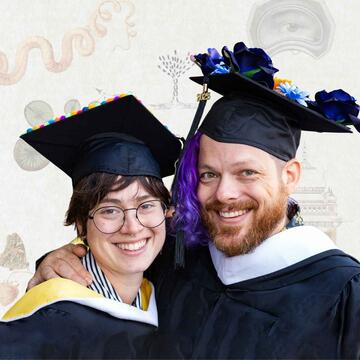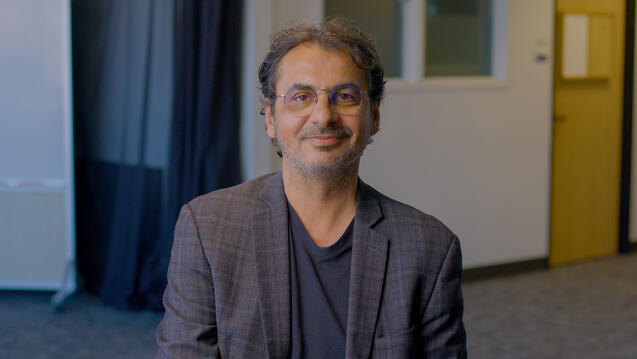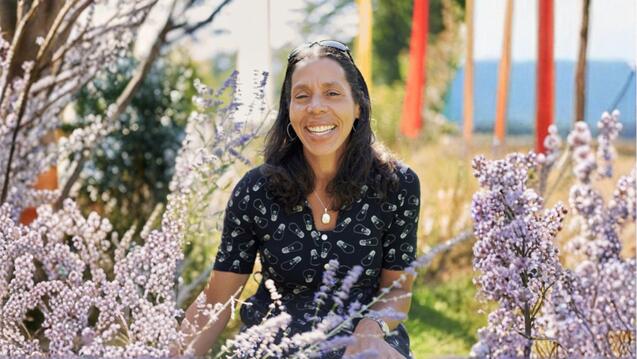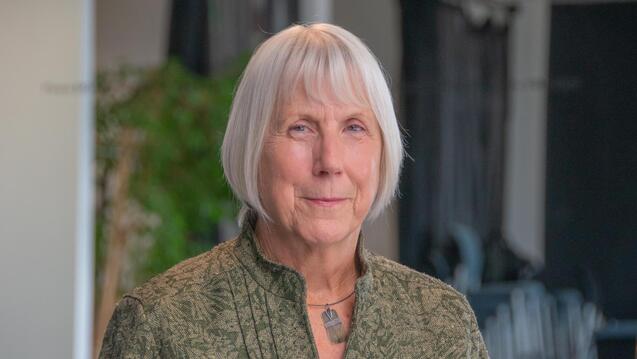Senior Lecturer Cosmin Gheorghe shares how CIIS' Bachelor of Science in Psychology helps students connect disciplines and find meaning in a fragmented world.

Drama Therapy Faculty Sylvia Israel Featured Therapeutic Spiral Model Trainer
Sylvia Israel, adjunct Faculty in the Drama Therapy program, is featured Therapeutic Spiral Model Trainer by Therapeutic Spiral Model International.
Sylvia Israel, Adjunct Faculty in the Drama Therapy program at CIIS, is featured Therapeutic Spiral Model Trainer by Therapeutic Spiral Model International. This is her interview.
Among Sylvia Israel’s (LMFT, RDT/BCT, TEP) many licenses and certifications, she is a creative, caring, and highly skilled trainer and practitioner in the Therapeutic Spiral Model for working with Trauma Survivors. Sylvia is also a founding member of Bay Area Moreno Institute (BAMI) and IMAGINE! Center for Creativity and Healing, her own center in San Rafael, CA. Additionally, Sylvia is on the faculty of California Institute of Integral Studies (CIIS) and Kansas State University (and has taught at other graduate programs); is Past-President of the Northern California Chapter of the National Association of Drama Therapy (NADT), and a Fellow of the American Society for Group Psychotherapy and Psychodrama (ASGPP).
Sylvia has been in private practice for 25 years in San Rafael and San Francisco CA working with individuals, couples, and families. She has presented at numerous national and international conferences, including most recently in Japan, with workshops and trainings covering a range of topics. To name a few: The Journey of Living and Dying; Steps to Forgiveness; Abundance—Deprivation: The Deep Psychology of Money; Cultivating Wisdom in Everyday Life, and Mindfulness/Loving-Kindness in Action.
From her professional and personal experience, Sylvia has seen that the essence of healing work is accepting oneself fully—the parts or roles that we like as well as those that we wish were otherwise. She believes that developing self-compassion opens to new ways of being and she enjoys supporting others in this journey through identifying and accessing strengths (TSM’s Prescriptive Roles), accessing ancestors, and healing childhood wounds. Being a child of Holocaust survivors herself, Sylvia finds gratification and a calling to work with others whose lives were touched profoundly by this trauma, including Healing the Wounds of History workshops with Armand Volkas.
In all of her work, she skillfully and creatively draws from expressive arts therapies including drama, art, movement and sandtray, and from somatic, cognitive, transpersonal and psychodynamic therapies. Sylvia is a ‘worker bee’ with many talents that she humbly and gracefully shares.
TSI: Hi, Sylvia, thank you for agreeing to be featured in our Summer 2016 News Update. You have many ‘initials’ after your name. Which do you identify yourself with the most?
Sylvia: I most identify with being a TEP (Trainer, Educator, Practitioner of Psychodrama). Psychodrama is the modality that I consistently enjoy teaching and using in my private practice. When I attended my first psychodrama training with Dorothy Satten almost 30 years ago, I was excited, touched and amazed. These many years later, I still experience Psychodrama in much the same way.
That being said, I must add that all those initials speak to the evolution of my professional life—all of my training and experience informs how I work with people and I how I direct psychodrama. Drama Therapy, in which I have my degree, has taught me about spontaneity and playfulness, something that Moreno greatly valued and is a basic principle of psychodrama. And, I’m fortunate to be part of a Playback Theater company where I get to participate in lots of spontaneity tests, as Moreno called them. In groups I often incorporate theater games or drama therapy exercises to increase the spontaneity.
My training as an LMFT has given me many lenses through which I can see my clients more clearly and direct psychodramas. For example, the more I learn about neuroscience and somatic therapies, the better I can understand what is happening in my client’s nervous system, influencing the tone of voice and choices I make as a psychodrama director. TSM’s training in the neurobiology of PTSD is an exciting workshop and I have enjoyed learning from it, as well as teaching it.
As you know, those of us in the healing professions understand that we bring all of who we are to our work. I have been enriched by every experience which the initials after my name represent.
TSI: What brought you to the ‘helping professions’? Was it a long-term dream or an inspirational moment?
Sylvia: Somewhere in between those two. I came to the healing profession through the doorway of theater. But as I look back over my life, I can see how the trauma in my family and the healing I needed contributed to my choice.
Growing up, the myth in my family was that people were either born artists or they weren't—and it was understood that we definitely weren't. In my late twenties, I moved to a Northern California coastal town where the prevailing belief was that everyone is an artist. With encouragement, I began taking art and dance classes and joined a community theater group. I soon was coming to the Bay Area to study physical improvisation, Action Theater, with Ruth Zaporah.
It was there in my theater work that I experienced a part of myself that had long been buried. I remember saying to my teacher, “This is more fun than I have ever had!” This enthusiasm took me to San Francisco State University's theater department where I first heard of drama therapy from a classmate. I knew intuitively that drama therapy would be a way for me to help others experience the joy I was feeling while keeping my own creativity alive. Stepping through the doorway of drama therapy opened me to the world of psychology, psychodrama, and many other practices. What I soon discovered was that I was really on a path that would deepen my connection to myself, others and to the world, and continually push me to my growing edges.
TSI: You’ve worked with TSM, Kate, Francesca, and other TSM people for many years. What is it that drew you here?
Sylvia: When I started with TSM in 1991, I was a beginning psychotherapist/drama therapist. As Moreno would say, I was in role-taking— really just trying on the role. I was very interested in psychodrama and keenly aware that I needed more training. One of my colleagues, Nina Strongylou, invited me, or I might say, persuaded me, to join the TSM training group. I did not have an understanding of what trauma was or why it was important to learn about it. I knew my family history was deeply affected by WWII. Both my parents were Holocaust survivors whose first spouses and children were killed, as well as all their siblings and parents. What I learned over time was how this trauma affected them and how it affected my living siblings and me. It became clear to me that in joining the TSM training I was in the right place to learn not only how to work with others, but also how to heal myself.
I offer this example to illustrate what a beginner I was and, also, how my work with TSM has been healing: I remember my first trauma drama. It was at Black Earth, Kate’s beautiful Psychodrama Center in the woods of Wisconsin. Kate was directing and asked me to show how the Holocaust affected my mother and me. I chose a 7-foot x 4-foot brown pillow (it was ugly and big!) and had the auxiliaries for my mother and me lie on the floor. I placed the pillow over them. The drama started with my mother and me ‘comfortably’ talking under the pillow. Pulled out to mirror position, I stood on the balcony with my double at my side observing. I had no reaction. It seemed normal to me. My double became quite agitated and said things like, “This is not right. It is wrong. I am angry.” It took a number of minutes for me to begin to understand that what I was witnessing was the impact of the Holocaust on both of our lives and that I could take action to form a different relationship with the Holocaust—and with understanding my mother and myself.
Additionally, as a new therapist, TSM gave me a clear sense of how to work with trauma. The Intra-Psychic Role Atom of the Trauma Survivor (TSIRA) became my guide. I felt that I had something to “hang my hat on.” It taught me how to formulate a treatment plan, a road map to where the work could go and how to work safely without re-traumatizing my clients. Right away, I began using the circle of strengths and the containing double. I saw how vital these two tools were to build the container. Later, I began bringing in the observing ego and trauma triangle, as well as the other roles in the TSIRA.
TSI: Eventually, you developed IMAGINE! Center for Creativity & Learning. What was your inspiration and intention? Do you have special groups or programs there? Can you give us a short tour through the Center? I.e., what you do, who else, etc.?
Sylvia: My inspiration and intention for IMAGINE! was, as I wrote above, to bring the joy I experienced in theater to others. Additionally, by the time I opened IMAGINE! in January 1999 I had enough experience with psychodrama to know that the greatest joy and laughter comes after diving deeply into the psyche, into the truth of what is, releasing long-time held feelings and beliefs, and coming out on the other side to an integration and transformation. That joy and laughter is wondrous and fully spontaneous! I wanted to support others in having that experience. I was inspired to tap into creativity for the purpose of healing. This continues to be my inspiration and intention to this day.
When I started IMAGINE! I had lots of programs and collaborated with various drama and expressive arts therapists. I published a printed newsletter a few times a year. That was a tremendous amount of work but also gratifying and beautiful! As the internet became more popular, I began using email. Visiting the IMAGINE! website gives much information about its history, former collaborators and workshops.
TSI: How do you organize the many avenues you pursue at IMAGINE!?
Sylvia: Since I have a private practice working with individuals and couples, there is one part of the office that I call the traditional therapist space, with a couch, chairs and rug. (When Francesca left the Bay Area she bequeathed to me, in addition to her sandtray items, her therapist chair, which I still happily use!).
There is a large open space that is used for movement, role play, and workshops. I now have a sizeable collection of objects for sandtray and art materials, including a CD player, musical instruments, and puppets and props. I love combining various expressive art forms such as using psychodrama in the sandtray; or drawing and enactment (starting with movement, then drawing, and finally enacting the drawing). There are so many exciting possibilities; we only have to use our imaginations, hence IMAGINE!
TSI: Is there a particular workshop or kind of workshop that fulfills you the most?
Sylvia: I have given workshops on many topics and have been particularly drawn to Buddhist themes. My colleague Jo Sopko and I once presented Mindfulness/Loving-Kindness in Action at Sprit Rock Meditation Center, an international center near my office. We followed up with a series of 5 monthly workshops at IMAGINE!, bringing in Loving-Kindness as a strength when dealing with the Buddhist Five Hindrances (sensual desire or greed; ill-will or aversion; sloth and torpor; restlessness & anxiety, and worry & doubt). I appreciate how 2500 years ago the Buddhists were proposing solutions to the same problems we now face. Working directly with TSM, Francesca and I conducted wonderful groups combining Sandtray and Psychodrama—Sandrama, a methodology she developed.
In addition to workshops, I provide psychodrama training and the TSM roles are an integral part of what I teach. For example, last weekend in a training on working with individuals, I demonstrated how to use the circle of strengths in a monodrama. After the protagonist created her own circle of supports including the Prescriptive Rolls—transpersonal, intrapsychic and interpersonal strengths—I directed the monodrama inside the circle. In the Introduction to Psychodrama class I teach at CIIS, I spend two full days focusing on trauma. Each student works in a sandtray looking at their personal roles of the TSIRA. I also teach the safety structures of working with trauma and the trauma triangle, using the book, Healing World Trauma with the Therapeutic Spiral Model (Hudgins & Toscani, 2013) as one of my textbooks. And, for the past two years, Kate has been coming to the Bay Area and we have offered, and will continue to offer, training and personal growth using the Therapeutic Spiral.
TSI: Well, this question follows on that last comment: In teaching and training others, what do you try to convey as THE essential feature. I.e., what would be a 'word of wisdom' to a new trainee, especially one who wants to work in volatile situations?
Sylvia: Have compassion for yourself. Open your heart to yourself. Buddhist teacher Stephen Levine (who recently died) said, “How sad to keep one’s self out of our own hearts.” I heard this years ago and it still touches me, even as I write this. When I started out, I would be so hard on myself, expecting that I could be skilled, be like my teachers. When I learned role theory, I was so relieved. Role theory says that just like a child learning to walk, you have to go through a developmental process when learning a new role: role-taking, role-playing and role-creating. You can’t be at role creating—that is where you are fully spontaneous and making up your own way of doing things—until you have first copied the role and played with it for a while. Remembering role theory and practicing compassion are practices we carry with us throughout our careers and, really, in every aspect of our lives.
I think I’d have to add that when working with trauma survivors or in volatile situations, ground yourself first. Resource yourself before you start and during the session as needed. No need to rush. You can slow things down and assess what is happening for you and for the client. This means learning how to notice your own reactions, your countertransference. The more you know yourself and do your own work, the more helpful you will be.
And, if I haven’t made this clear before, I must say that when working with trauma, follow the TSIRA. It really is a road map. You will find your own way to use it. Don’t get hung up on every detail. Use what is helpful.
TSI: You’ve been involved with Bay Area Moreno Institute (BAMI) now for years. Can you tell us something about that?
Sylvia: In 2007, Mario Cossa, TEP and trainer in the TSM model, moved to the Bay Area. He and Gina Moreno (JL’s daughter) wanted to start a Psychodrama institute to honor Zerka and JL and use the Moreno name. They invited John Olesen, TEP and me to join and, since I had been working on my own for a number of years, I felt it was time to collaborate. Mario has since moved to Bali, leaving John and me as the main trainers. We also have brought in other trainers such as Kate Hudgins, TEP and Kate Cook, TEP. BAMI, just like IMAGINE! is still evolving. We continue the work of bringing psychodrama to the Bay Area and beyond, while most of the trainings are offered at IMAGINE!
TSI: Where do you see yourself heading in the next years? Anything on the horizon?
Sylvia: What’s on the immediate horizon, of course, is my continued work as a TSI trainer conducting workshops with Kate. We have an advanced clinical one scheduled on the Dance of Transference and Countertransference for September. And, we’ll be doing another advanced one on Projective Identification in March of 2017. I love giving these trainings with people from all over the country. I leave feeling renewed and enriched. I think Kate and I work so well together because we both respect each other and the work/model.
Also, this Fall, as part of the BAMI core training group, I plan to devote at least one weekend of the Core Training Group to trauma, drawing upon the TSM model. As at CIIS, students will work in their sandtray, exploring the TSIRA.
In March 2016, I was fortunate to have the occasion to travel to Japan. Mika Yamaguchi, a Japanese expressive arts therapist trained in America, arranged for me to give workshops in Playback Theater and Psychodrama. People were incredibly open and willing to explore. Though I did not understand everything that was said in the workshops, I felt no communication or cultural barriers. One of the women who attended both workshops wrote me a note saying, “Thank you for helping us connect.” What more could a psychodramatist hope for?
I feel grateful to have had the chance to bring these action methods to Japan and to feel our connections rather than differences. I greatly enjoyed the opportunity to teach internationally over the years and to experience how different cultures respond to psychodrama. So, for the future, I hope to do more international teaching.
For the past few years, I have been studying Somatic Attachment Therapy and Family Constellations. I see both fields as “cousins” of Psychodrama and TSM, and are a natural fit with action methods. I have been incorporating them into my work and look forward to doing more.
TSI: You are a ‘worker-bee’, Sylvia, but I know you play also. What particular things do you enjoy doing to uplift your spirits and enable you to continue in your work?
Sylvia: I love my work and feel fortunate to have found something that is both creative and satisfying. But connecting with nature has long been a way for me to lift my spirits and calm my mind. So, from my home on Mt Tamalpais, outside of San Francisco, I can walk into the woods and to lakes.
I also have been practicing Tai Chi for 7 years, a beautiful practice—and very challenging. It reminds me, as does nature, that everything is connected and it helps me get out of my head to focus on something other than work. I never plan to teach Tai Chi—I can just enjoy it—which is a great relief, as most other classes I take relate to my work.
About 13 years ago I helped start Bay Area Playback Theatre, of which I’m still a part. Having a place to play and do improv is fun and also sustains me.
I live with my partner/spouse Sheryl and our dog Star. Sheryl and I have been together for 32 years. I enjoy spending time with her at home or getting together with friends and family. I don’t dance enough but when I do I greatly enjoy it and the SF Bay Area has so much to offer in the way of art, drama, music and film.
So, essentially, my plans for the future—if the future allows it—are a continuation of the health and happiness I feel now. Here’s hoping!
Read more about The Therapeutic Spiral Model.
Read more about Sylvia Israel on her bio page.
Related Academic Program
Master of Arts in Counseling Psychology, Concentration in Drama Therapy
Related News
Professor Jeanine Canty explores how the Transformative Studies Ph.D. prepares visionary changemakers to address humanity's disconnection from nature and each other.
Dr. Janis Phelps founded the world's first academically approved psychedelic therapy training program, preparing clinicians for a transforming field of mental health.



